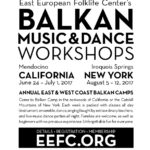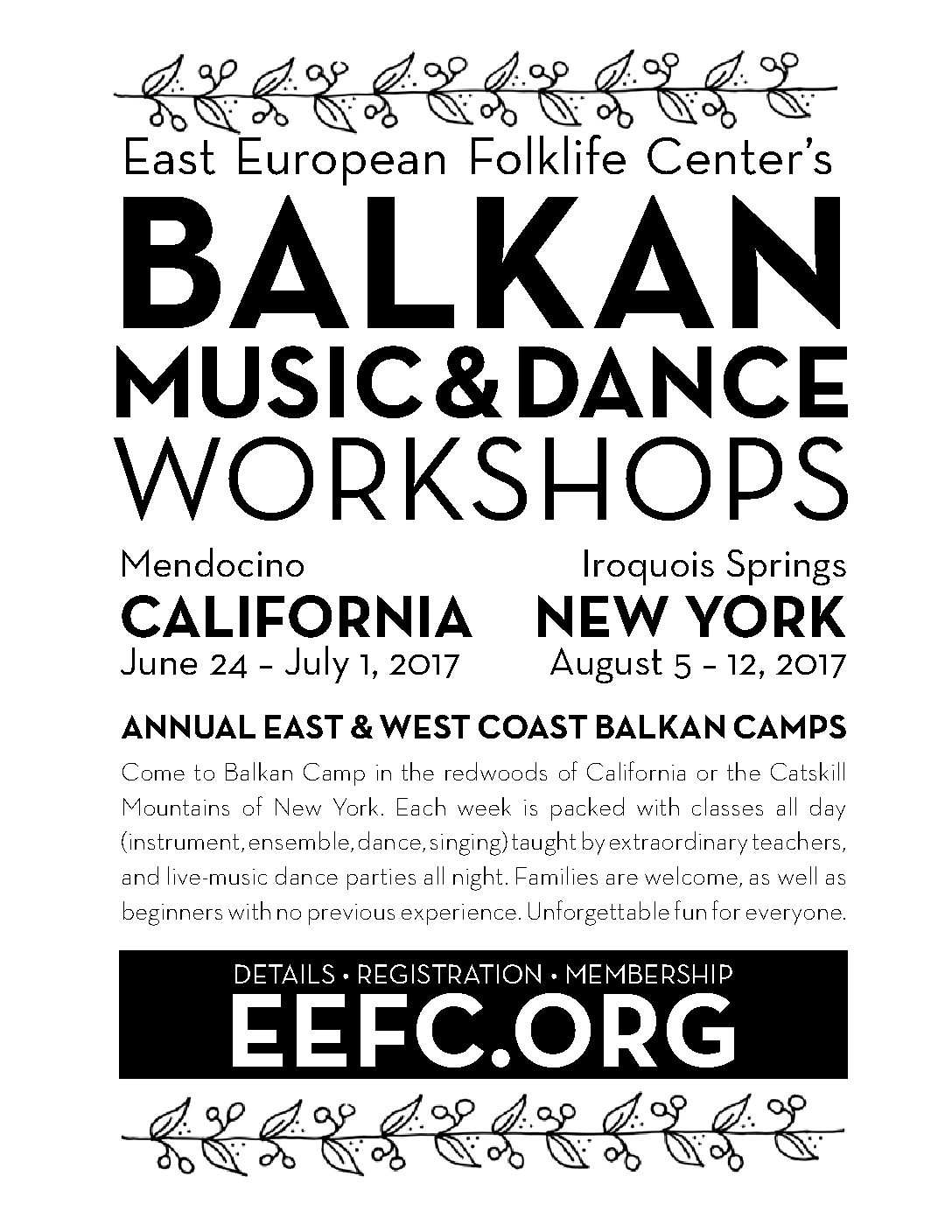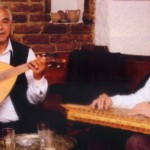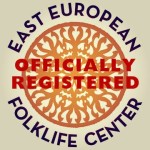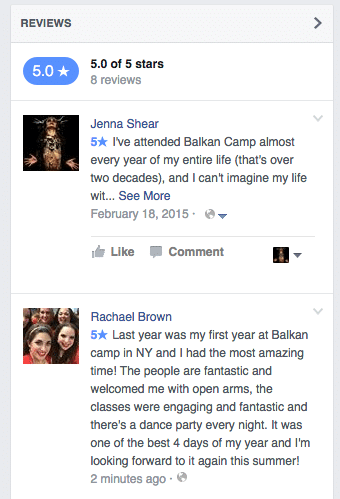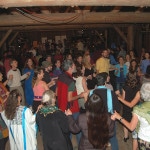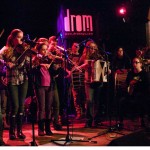The Board of Directors met in New York City on October 16 & 17, 2015.
Election of Officers, Committee Chairs, and Task Force Leaders
By consensus:
President – Corinna Snyder
Vice President – Helen Marx (this year, VP will create board agendas and take board meeting notes)
Secretary – Noel Kropf
Treasurer – Barbara Uhlemann
Committee Chairs
Marketing – Elena Erber
Finance – Barbara Uhlemann
Development – Amy Mills
Program – Demetri Tashie
Scholarship (co-chair) – Barbara Uhlemann
Administration – Corinna Snyder
Ad Hoc Task Forces
Technology – Noel Kropf
Planning Committee for Strategic Planning – Helen Marx, Corinna Snyder, Elena Erber
College Credit/Relationships – Helen Marx, Elena Erber
Kafana Succession – Helen Marx
Instrument Library – Corinna Snyder
Marketing Committee Update
(Elena Erber, Chair)
Accomplishments since last meeting
- Regular newsletter consistently published with better range of communications (Facebook, EEFC listserv, email)
- “Ripple Effect” is a good concept. Look for more ways to use it
Goals for coming 6 months
- Ensure a secure workshop registration page and forms
- Document and follow an advertising/marketing calendar
- Work more closely with Programming and Fundraising Committees
Goals for next 12 months
- Shopping: complete an online store
- Add a page that lists all teachers that we have in the database
- Add class descriptions to 2016 workshop information
- Complete migration of content from the old to the new website
2015 Camp Recap
(Rachel MacFarlane, General Manager)
General notes
- Lower enrollment this last year
- Consistent high-quality teaching and general camp experience
Improvements for the coming year
- Increased teacher honorarium
- Posting of Iroquois Springs B&B info (how it works, cost) at the same time as general registration
Goals for coming 6 months
- Put in place a new evaluation system (something better than Survey Monkey) so workshop data can be pulled and aggregated in more useful ways
Program Committee Update
(Demetri Tashie, Chair)
Accomplishments since last meeting
- Added interns who may later join the committee as full members
- Teachers listed publicly sooner than in the past
Goals for coming 6 months
- Interns – design a system for evaluating our interns
- Work with Marketing to post class descriptions on the website
- Work more closely with Marketing so that information about upcoming workshops can be published earlier and to a wider audience
Goals for coming 12 months
- Evaluate interns
- Complete a succession plan for committee personnel
- Begin planning for the following year prior to camp
- Work with the board on planning the future of children’s and young adults’ programming, with the goal of improving our sustainability with future generations of campers
Finance Committee
(Barbara Uhlemann, Treasurer and Chair)
Accomplishments since last meeting
- Significant amount of cleanup of current and past fiscal years’ data in QuickBooks Online
- Balance Sheet accounts created for Scholarship and Nest Egg funds
Decisions at meeting
- Created new board cost budget line item to cover total cost of board activities including board meeting travel, food, space and supplies
- To better track and document the operational costs of Board meetings and other Board expenses, board members agreed that they will submit requests for reimbursement for board meeting expenses. Board members will then, within their ability, donate the reimbursed amount back to the EEFC
- Agreed to reflect board member tuition waiver in the books
- Agreed to increase teacher travel expense budget by 4% (cost-of-living)
- Agreed to raise workshop tuition rates 3% (cost-of-living)
- Agreed to raise teacher compensation by $50 per class
- Agreed that committees can come to the board to request increase or trading of budget amounts
- Draft budget approved by consensus
Goals for coming 6 months
- Finalize the 2016 budget (1 month)
- Finish cleanup in QuickBooks and decide if we should continue using QuickBooks Online (2 months)
- Clarify budget items and return to the board for review (2 months)
- Calculate a “total cost” average (3 months)
- Calculate true cost of a scholarship
- Establish an investment vehicle for the Agin Scholarship gift, future gifts (3 months)
- Decide about a potential vehicle for cash on hand
Goals for coming 12 months
- Integrate Salesforce shared database with QuickBooks Online
Fundraising
(Amy Mills, Chair)
Accomplishments since last meeting
- Added new members to the committee
- Worked on streamlining and improving fundraising activities at camp
- Collaborated with Marketing on fundraising messaging
Discussion
- We need to plan for what our development goals are, to build a fund of money that makes us more sustainable. We cannot just bridge gaps on a year-to-year basis.
- Need better access to data to do effective fundraising
- We are not looking for grants. We aren’t in the right position and there aren’t many available
- Clarification of the board’s role at camp in fundraising
- Does the board add any value to the auction process?
- Can the board have a brighter presence at camp, acting more as leaders in the charge to raise funds?
- Membership: is it working to have the levels that we have?
- How can we best get the message out that the best and main way to grow our community is for the community to bring new campers to camp? The board’s role is to drive the fundraising that supplements the funds we take in via tuition, and which do not cover the total cost of running the organization.
Improvements for the coming year
- Work with the auction team to share our goal for the amount of money we need to raise at auction every year
- Keep the scholarship amount raised at camp separate from the auction cash total
- Initiate large gift asks at camp
Goals for coming 6 months
- Year-end appeal (6 week)
- Define Membership (6 month)
- Initiate Direct Ask program by Board (6 month)
- Identify and assess potential donors from our current lists
- Clarify the pitch
- Support for operations because that is what we really need now
- Donations do not need to be for any particular use unless donors specifies
- We are (for now) covering a $30,000 deficit, which can be broken down in a variety of ways
- Face-to-face asks are best. Askers: Barbara, Helen, Noel, Corinna, and Demetri. Amy to ask Craig Kurumada for ideas for West Coast volunteers
- Elena to help with the message, Rachel with identifying possible givers
- Identify how to work more closely with Marketing
Goals for coming 12 months
- Institutionalize the process of regular appeals (12 month)
Scholarship Committee Discussion
Discussion
One year ago it was decided that the Scholarship Committee would not require a board member as chair. Over the past year, it has become clear that scholarships are a significant part of our fundraising efforts, and can and should be thought about more strategically, in terms of helping us establish new community connections and supports.
Decision
It was agreed that going forward the committee chair should be shared: one person from the Board, and one committee member. Corinna will discuss these changes in the committee organization with current chair, Ann Norton. The board member’s responsibility is to define the strategic direction of the committee and align it with the strategic efforts of the Board and the organization as a whole. The board agreed that Barbara will serve as the Board co-chair. Her next steps are to learn the criteria for each of the scholarships, and communicate the amount of money to be given this year in scholarship funds.
Decision
The board agreed to make $10K available for scholarships this year.
Goals for future discussion by Scholarship Committee:
- Address drop in child attendance at camp and potential ways to support longtime child campers who are now young adults and aging out of the “kids” category
- Identify a variety of Scholarship categories
Ad Hoc Tech Task Force
(Noel Kropf, Chair)
Salesforce Presentation
- Martie Ripson gave a presentation showing some of the things SF can do
- Can it help with rotating memberships? Yes
- Comes with 10 users, with customized permissions
- Researching if SF can send automatic letters (ex: donation confirmation)
- Wide range of filtering for creating reports
- Timeline: by 2016 move over to Salesforce
- Integrate with MailChimp
- Map forms from website to SF
- Map from SF to website
- Eventually map SF to Quickbooks
Goals for coming 6-12 months
- Move operations from FileMaker Pro to Salesforce (6 month)
- Integrate workshop registration into Salesforce (6 month)
- Create and have operational an online document archiving and creation platform (6 month)
- Integrate with MailChimp (12 month)
- Create plan to integrate with QuickBooks Online (12 month)
- Collaborate with Finance relating to decisions about QuickBooks Online (12 month)
Administration Committee
(Corinna Snyder, President and Chair)
Accomplishments since last meeting
- Redefined General Manager role and compensation; hired Rachel MacFarlane to fill the position
Goals for coming 6 months
- Complete the Administrative Assistant job description/search/hire (3 months)
- Create a working organizational bylaw proposal. Noel Kropf to co-chair effort (6 month)
- Have a 6-month check-in performance review conversation
Goals for coming 12 months
- Up-to-date, reviewed and ratified organizational bylaws
Strategic Planning Conversation
Summary
Two consultants joined the board to talk with us about strategic planning. They:
- Summarized the goals and outcomes of a strategic planning exercise
- Clarified what is needed to successfully engage in the process. The following were discussed as part of the process: significant information gathering (documents and interviews/surveys/focus groups) and data analysis, setting of clear roles and responsibilities, providing realistic assessment of what can, in reality, be accomplished by the organization we have now, how to define goals with objectives and progress points that can be measured
- Identified the pitfalls that organizations face when they decide to create a strategic plan
- Explained the difference between a strategic plan and “planning to be strategic”
- Emphasized that such planning needs to begin with a delineation of the questions that need to be answered toward goals
- Explained the different roles board members, outside consultants, community members and staff can and should play in the process
- Illuminated the value of a plan “champion,” the person who promises to make the plan happen, and implements it.
Over the course of the discussion the following realities became clear to the group:
- We have a beloved and important program (our two camps) and as a board and a community our core goal is to assure its sustainability
- We do not currently have the capacity (resources/staff/infrastructure) nor an immediate need to implement a significant strategic plan
- Our current need is to develop a more immediate plan (18-36 months) to make the EEFC sustainable–financially solid with a strategic fund development plan in place.
We agreed that our goals are to have:
- A fund development plan, a secure income stream and a solid base of funds well invested to provide returns over the long term
- A clear understanding of who current members/camp participants are, and a clear understanding of who our future members/camp participants might be, and a plan for turning them into campers
- The right amount of staff, infrastructure and resources for us to be sustainable, with the goal of having the capacity to grow in the future in response to board and community goals.
We agreed we need to spend the next 36 months focusing on:
- Raising money, including investing in an outside resource to help us figure out how we can best accomplish it
- Looking systematically at the current programs and making adjustments to keep attendance at a sustainable level
- Understanding changing demographics in the community and larger forces that impact our membership and camp attendance, both now and in the near future
- Exploring potential future categories and sources of members and camp participants, and strategic marketing strategies for populations that are currently underrepresented at camp (e.g. immigrant communities, music students, dance students, college students, elders, etc.
We agreed that we need help knowing what questions to ask, how to find answers and what data will help illuminate the questions. We identified two skill sets that we need to bring to the effort:
- Funding development. An outside consultant who has experience helping organizations like ours (small, arts-based, community-focused, committed to its current state of programming, no current capacity to grow) develop plans for fundraising
- Program assessment and refinement. A consultant who will help us understand the changing demographics within our community and identify strategies for increasing members and camp participants, including an assessment of how our current approach to programming might be impacted by such changes.
Decisions:
We established an Ad Hoc Strategic Planning Committee: Corinna Snyder, Helen Marx and Elena Erber volunteered, with support from Rachel MacFarlane, to create a plan for spearheading this process.
6 month goal:
Deliver a timeline-based project plan with major tasks and milestones, roles and responsibilities, and resource needs (people, money, technology) for creating a sustainability strategy and plan for the EEFC.
